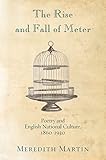The Rise and Fall of Meter : Poetry and English National Culture, 1860--1930 / Meredith Martin.
Material type: TextPublisher: Princeton, NJ : Princeton University Press, [2012]Copyright date: ©2012Edition: Course BookDescription: 1 online resource (288 p.) : 4 halftonesContent type:
TextPublisher: Princeton, NJ : Princeton University Press, [2012]Copyright date: ©2012Edition: Course BookDescription: 1 online resource (288 p.) : 4 halftonesContent type: - 9780691155128
- 9781400842193
- English language -- Versification
- English poetry -- 19th century -- History and criticism
- English poetry -- 20th century -- History and criticism
- National characteristics, English, in literature
- Poetics -- History -- 19th century
- Poetics -- History -- 20th century
- LITERARY CRITICISM / Poetry
- Arthur Brock
- Craiglockhart War Hospital
- English education
- English language
- English literature
- English meter
- English poet
- English poetry
- English prosody
- English soldiers
- Ezra Pound
- George Saintsbury
- Gerard Manley Hopkins
- Henry Newbold
- Matthew Arnold
- Milton's Prosody
- Robert Bridges
- Society for Pure English
- Victorian England
- Victorian meter
- Victorian tradition
- W. H. R. Rivers
- grammatical history
- literary movements
- metrical communities
- metrical culture
- metrical history
- metrical mastery
- metrical poetry
- national identity
- patriotic pedagogy
- poems
- poetic form
- poetic meter
- poetry writing
- poetry
- poets
- prose
- prosody
- state-funded education
- 821.809 23
- PR595.V4 M37 2017
- online - DeGruyter
- Issued also in print.
| Item type | Current library | Call number | URL | Status | Notes | Barcode | |
|---|---|---|---|---|---|---|---|
 eBook
eBook
|
Biblioteca "Angelicum" Pont. Univ. S.Tommaso d'Aquino Nuvola online | online - DeGruyter (Browse shelf(Opens below)) | Online access | Not for loan (Accesso limitato) | Accesso per gli utenti autorizzati / Access for authorized users | (dgr)9781400842193 |
Frontmatter -- Contents -- Acknowledgments -- Introduction: The Failure of Meter -- Chapter 1: The History of Meter -- Chapter 2: The Stigma of Meter -- Chapter 3: The Institution of Meter -- Chapter 4: The Discipline of Meter -- Chapter 5: The Trauma of Meter -- Chapter 6: The Before- and Afterlife of Meter -- Notes -- Works Cited -- Index
restricted access online access with authorization star
http://purl.org/coar/access_right/c_16ec
Why do we often teach English poetic meter by the Greek terms iamb and trochee? How is our understanding of English meter influenced by the history of England's sense of itself in the nineteenth century? Not an old-fashioned approach to poetry, but a dynamic, contested, and inherently nontraditional field, "English meter" concerned issues of personal and national identity, class, education, patriotism, militarism, and the development of English literature as a discipline. The Rise and Fall of Meter tells the unknown story of English meter from the late eighteenth century until just after World War I. Uncovering a vast and unexplored archive in the history of poetics, Meredith Martin shows that the history of prosody is tied to the ways Victorian England argued about its national identity. Gerard Manley Hopkins, Coventry Patmore, and Robert Bridges used meter to negotiate their relationship to England and the English language; George Saintsbury, Matthew Arnold, and Henry Newbolt worried about the rise of one metrical model among multiple competitors. The pressure to conform to a stable model, however, produced reactionary misunderstandings of English meter and the culture it stood for. This unstable relationship to poetic form influenced the prose and poems of Robert Graves, Siegfried Sassoon, Wilfred Owen, W. B. Yeats, Ezra Pound, and Alice Meynell. A significant intervention in literary history, this book argues that our contemporary understanding of the rise of modernist poetic form was crucially bound to narratives of English national culture.
Issued also in print.
Mode of access: Internet via World Wide Web.
In English.
Description based on online resource; title from PDF title page (publisher's Web site, viewed 29. Jul 2021)


